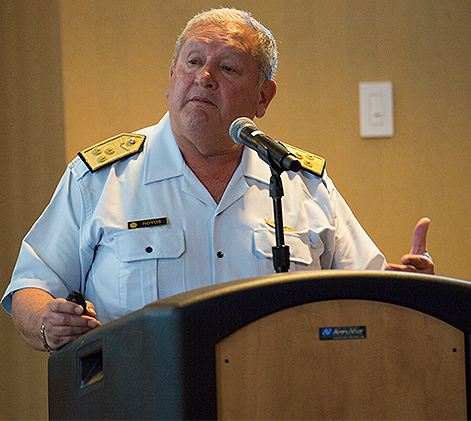 |
Peruvian Air Force Lieutenant General Raúl Hoyos de Vinatea, head of the Peruvian General Staff, during his presentation on the Peruvian Air Force’s capabilities at the South American Air Chiefs and Senior Enlisted Leaders Conference. (Photo: AFSOUTH Public Affairs) |
Peruvian Air Force (FAP, in Spanish) Lieutenant General Raúl Hoyos de Vinatea, head of the Peruvian General Staff, attended the South American Air Chiefs and Senior Enlisted Leaders Conference, held at Davis-Monthan Air Force Base in Tucson, Arizona, November 4-8, 2019. Lt. Gen. Hoyos spoke with Diálogo about cybersecurity and the transnational crimes that affect his country.
Diálogo: What’s the importance of FAP’s participation in the South American Air Chiefs and Senior Enlisted Leaders Conference?
Lieutenant General Raúl Hoyos de Vinatea, head of the Peruvian General Staff: We want to team up and partner with the United States, so we can focus the combined efforts of both nations and air forces on the main issues that we have in the region, such as transnational threats, which in Peru’s case are mainly related to illegal mining, illicit drug trafficking, terrorism, transnational crime, and corruption.
Diálogo: Cybersecurity and space were central topics at the conference. What are Peru’s advances in this domain?
Lt. Gen. Hoyos: Our main advance was the August [2019] enactment of the Cyber Defense Law 30900, giving the Armed Forces the legal framework to support the State in countering the threats or attacks that affect national security and to conduct cyberdefense operations. We’ve also acquired, for nearly $7 million, all the equipment for the Peruvian Cybersecurity and Defense Operations Center — based in Lima and with branches in every region of the country — that will be operational in December.
Diálogo: What is the experience with the first Peruvian earth observation satellite, known as PeruSat-1?
Lt. Gen. Hoyos: PeruSat-1 is a satellite created for national security and defense purposes, and it’s also crucially important for the country’s socioeconomic development. The satellite is operated by the National Commission for Aerospace Research and Development, an institution under the Ministry of Defense. For national defense and security purposes, we are using imagery to detect areas with illegal mining and narco-terrorist camps. So far, the country has saved more than $206 million on processed imagery — satellite images that we used to purchase.
Diálogo: In your presentation, you said that illegal mining was one of the main scourges for the country’s security. Are there any foreign actors involved in this crime?
Lt. Gen. Hoyos: Illegal mining in the Puerto Maldonado area, in the Amazon, is a transnational threat. Although there are Peruvian illegal miners (a minority), there is a great deal of transnational capital from private actors, who bring in dredges and machinery through the borders and operate in rivers to exploit gold illegally, polluting and deforesting the jungle. The Peruvian Armed Forces have sent a division of special forces to the area, and we plan to maintain a permanent air group in the area.
Diálogo: Some of FAP’s main duties are humanitarian assistance and natural disaster relief. How does FAP prepare to respond to these kinds of events?
Lt. Gen. Hoyos: Our training includes a good number of helicopter and cargo plane flight hours and personnel involved in disaster relief operations. We conduct Wings of Hope exercises, where we simulate a disaster and put in practice all our operational and logistical capabilities. These exercises are used by other sectors of the State to bring real assistance to simulated disaster areas. We also take part in Cooperation, an annual exercise coordinated by the System of Cooperation among the American Air Forces.
Diálogo: What technological innovations does the Project Research and Development Center (CIDEP) offer?
Lt. Gen. Hoyos: CIDEP is focused on the design and production of tactical unmanned aircraft with an average reach of 62 miles, and on the production of airplane and helicopter simulators that FAP uses, such as the Twin Otter airplane and the MI-17 helicopter. Obviously, CIDEP also has its own research projects, such as the production of voice recording systems for control towers, among others.
Geraldine Cook
Source News
No comments:
Post a Comment
Note: Only a member of this blog may post a comment.